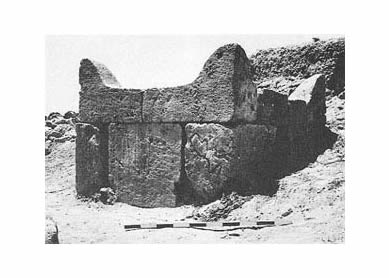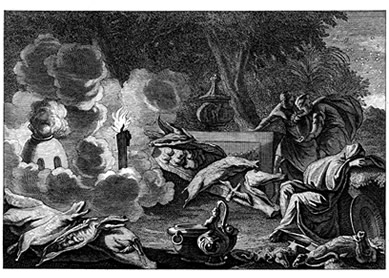One way to think about ancient sacrifices is as “gifts” given to God. When they performed sacrifices, ancient Israelites gave to God some of what they believed God had given them, expressing their close relationship with God and seeking to deepen that bond.
In the Hebrew Bible, sacrifice always involves transformation. One of the most common ways to transform something is to destroy it. Destruction removes the animal from the ordinary realm and transfers it to a transcendent one. Biblical texts tell us that God received the smoke of the burning sacrifice as a “pleasing odor” (see, for example,
The temple was a domestic setting, the place of God’s presence with the nation. One of the most common terms for the temple was ”house,” and it had furnishings, such as a lamp and a table. The altar was a cooking surface, a barbecue, so to speak, where the sacrificial animal was “cooked.” Burning up or “over-cooking” the sacrifices in the altar fire marked out the specialness of the food offerings.
Instructions for the performance of various types of sacrifices are found in the first seven chapters of the book of Leviticus. There are five main types of grain and animal sacrifice:
- Burnt offering (Hebrew, ‘olah; literally, “ascending offering”;
Lev 1 ,Lev 6:8-13 ) could be a herd or flock animal (bull, sheep, or goat) or a bird (dove or pigeon). The whole animal was burned in the altar fire. It was the most extravagant sacrifice because the entirety was given to God. - Grain offering (Hebrew, minhah; literally, “gift”;
Lev 2 ,Lev 6:14-23 ) was an offering of fine flour or unleavened baked goods, mixed with oil. A handful of the offering was burned (with incense) in the altar fire. The rest went to the priests. - Sacrifice of well-being/fellowship offering (Hebrew, zevah shelamim;
Lev 3 ,Lev 7:11-35 ) could be a herd or flock animal. Innards (fat, kidneys, and part of the liver) were burned in the altar fire. Most of the animal was eaten, divided between the priests and the offerer. This sacrifice was associated with feasting and well-being. - Sin/purification offering (Hebrew, hatta’t;
Lev 4:1-5:13 ,Lev 6:24-30 ) dealt with disruption in the relationship between human beings and God. The offering depended on the identity and status of the person required to make it. The chief priest, for example, had to bring a bull, whereas ordinary Israelites brought a female goat or lamb. Those who were too poor to afford a goat or sheep could offer birds, and an offering of grain flour was acceptable from the very poor. - Guilt offering (Hebrew, ’asham; literally, “responsibility”;
Lev 5:14-6:7 ,Lev 7:1-10 ) dealt with distinct categories of wrongdoing that disrupted the divine-human relationship, such as unintentional desecration of sacred things. The prescribed sacrifice was a flock animal. As with the sacrifice of well-being and the sin offering, innards were burned in the altar fire; the animal’s flesh was eaten by the priests.
These five varied sacrificial offerings have one element in common: the burning of some portion in the altar fire to transform the offering into smoke or a “pleasing odor” that God could enjoy.
Sacrifice is not a do-it-yourself activity in Leviticus. Rather, priests are required to bring about the transfer and transformation of the offering. Not only are they expert in the proper procedures, but they also bear the risk of moving into God’s presence.
Every animal sacrifice includes special treatment of the animal’s blood, which various biblical passages identity with the life force of the animal (see, for example,
Bibliography
- Gilders, William K. Blood Ritual in the Hebrew Bible: Meaning and Power. Johns Hopkins University Press, 2004.
- Gorman, Frank H. “Sacrifices and Offerings.” Pages 20–32 in vol. 5 of The New Interpreter’s Dictionary of the Bible. Edited by Katharine Doob Sakenfeld, Samuel E. Balentine, and Brian K. Blount. Nashville, TN: Abingdon, 2009.
- Bergen, Wesley J. Reading Ritual: Leviticus in Postmodern Culture. Journal for the Study of the Old Testament Supplement Series 417. New York: T&T Clark, 2005.




